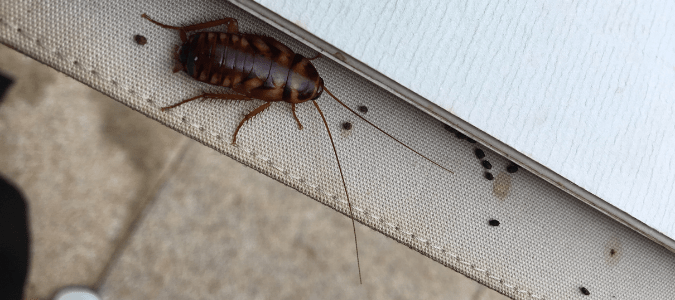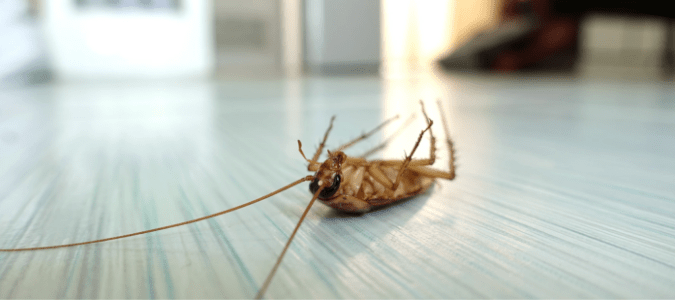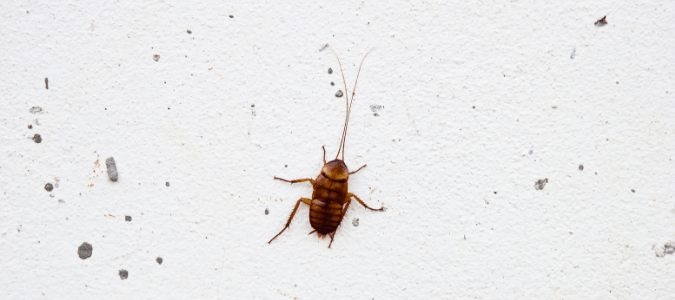Many of us have been through this scenario: You walk into the kitchen or bathroom after dark and flip on the light only to see a roach skitter across the wall or countertop. After a shudder or two, you make an action plan, trying to figure out how to rid your home of these seemingly indestructible insects.
A quick online search turns up a ton of “surefire” solutions, from hosing your home down in chemicals to using pantry items like vinegar to do the job. The problem with chemicals is the lingering fumes and the danger they and the chemicals themselves pose to people and pets. And, distilled vinegar and other household items just don’t work.
One common liquid that gets a lot of online attention in the battle with roaches is bleach. So, can bleach kill roaches? Technically, it COULD. But the methods to do that are pretty inefficient and time-consuming.
Bleach’s Effect on Roaches
Roaches will die if they are drowned in bleach, however you would need to get every single roach in your home, one by one, and dunk them to get the job done. That is unappealing to just about everyone in the world and is also not worth the effort.
Taking a deep drink of household bleach would kill anything, roaches included. But the same strong odor that keeps people from taking a swig of bleach repels roaches as well. So though it could work, in reality, it will not. It is very difficult to kill an entire roach infestation yourself. If you don’t get them all, they will reproduce. If you don’t seal up every single point of entry, they will keep coming in. The easiest and most effective way to send roaches packing is to call in a licensed pest control professional. They can formulate a plan of action and keep insects away with a regular treatment plan.
Bleach can be a useful tool for keeping roaches from visiting in the future. It is an effective and common cleaning agent in many homes, and the pungent aroma of the chlorine it contains is familiar to just about anyone. Turns out, roaches can’t stand the overwhelming smell, either! So using bleach to thoroughly clean areas after roaches have been eradicated will definitely help deter a return.
What Attracts Roaches?
Roaches are attracted to a space by the smell of food, which to these insects can be many things. Cleaning with bleach removes such aromas, and the roaches will move on. Another reason bleach isn’t your best bet is that, unlike some other preparations, bleach is not transferred from one roach to another. This makes it almost impossible to kill an entire nest.
Roaches show up for food and water, with even a few crumbs being enough to bring a hungry insect and its friends to explore the rest of your home’s offerings. Getting rid of them really is a job for pest control professionals. However, there are a number of things that you and your family can do for DIY cockroach prevention:
- If you have even a slight plumbing leak, fix it. If you regularly see moisture building up in a bathroom or other area, add proper ventilation to wipe out a potential water source for bugs.
- Be sure to store any food not refrigerated or frozen securely in glass jars or re-sealable containers, anything that doesn’t allow access for roaches and other pests.
- Use a vacuum to get rid of any crumbs or food debris that might have fallen in cracks and crevices in your home, including cushions of your furniture. This will also get rid of any roach droppings, eggs or shed skin, and that will prevent another batch of the bugs from visiting.
- When roach droppings and the shed skin travels through the air, it can all cause allergies for you and your family. To help that situation, use a HEPA filter or triple filter in your vacuum.
- If you have a counter with a little spilled juice or soda, be sure to wipe it up immediately.
- Don’t store filled trash cans near doors. Keep all trash secured tightly, and don’t let old newspapers, rags or boxes stack up, as they all provide a place for roaches to nest and multiply.
American Cockroach Infestation
Roaches have been skittering across the earth for more than 300 million years and easily adapt to new situations, making them difficult to destroy. There are around 3,500 types of cockroaches in the world, with 55 or so in the United States. First, let’s look at the American cockroach itself.
These roaches have three growth states: egg, nymph and adult. Female roaches drop quarter-inch capsules that contain about 15 eggs each in places near food. The egg stage lasts between 30 to 60 days, depending on the environment.
The nymphal stage can last from 150 to almost 1,000 days. At first, nymphs are a grayish-brown color but turn into a reddish-brown after a few molts. They have no wings. Adult American cockroaches are one and a half inches long, with both males and females having wings the length of their abdomen. Female roaches produce about 800 offspring over their lifetime, which can be about 15 months.
These roaches love dark, warm, moist spots, and if you spot them in the house, it will likely be in certain areas first. Damp basements, crawl spaces, clothes hampers, around sinks, dishwashers and bathtubs are among roaches’ favorite places. They hide during the day, looking for food at night and running quickly if disturbed.
The whole reason roaches are in your home in the first place is to find food and water. They will feast on all kinds of things, from spilled food and liquids in the kitchen to trash anywhere in the house. They’ll even eat unexpected things such as the starch used in books and papers. Adult American cockroaches can live two to three months without food and a month with no water. They have no problem living in extreme temperatures.
How to Know If You Have an Infestation
Because roach infestations are very difficult to control, bring in a licensed pest control professional. You will have peace of mind knowing that your uninvited guests have been sent packing and know how to get rid of cockroaches.
It can be difficult to tell the signs of a full-blown roach infestation or if you just have a couple of American cockroaches seeking food. You will never be able to see all of the roaches that might be hiding in your home, so a survey of the roaches is in order. A pest control professional is the one to contact for this service called trapping.
They will put sticky traps at specific places in the building that are likely to have roach traffic: against a wall, a corner, a shelf, drawer or under kitchen equipment and counters. A week of trapping will give the pest expert enough information to determine if you have an infestation. If you do, they will determine what kind of treatment would be best suited to the level of problem that you have. Regular maintenance by professionals will help keep those roaches (and other pests) from returning.
Can Roaches See?
When you spot a roach in your home, usually at night, they will run away as fast as they can, trying to avoid you and the light you switch on. There is actually a reason for that – besides wanting to stay away from a shoe you might aim their way.
These insects use their senses of smell and touch to figure out where they are going as they move about your home. Science has discovered that cockroaches also can actually see where they are going, even in complete darkness.
Roaches have compound eyes and on those eyes, each roach has thousands of light-sensitive cells. Research suggests that roaches use a yet-unknown neural process in a deep part of their brains to process all the visual information these cells take in. Further study by scientists could help them understand this process and design better imaging systems for humans’ night vision.
ABC Can Implement Effective Roach Control Solutions
At ABC Home & Commercial Services, we use a multi-tiered approach to pest control. We will inspect your home and find where the roaches are nesting. Then, we will implement targeted cockroach control measures, so you can feel at ease again.


